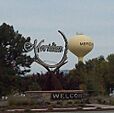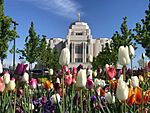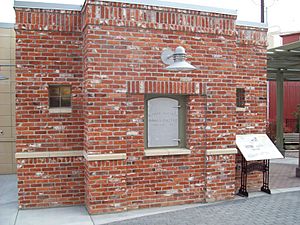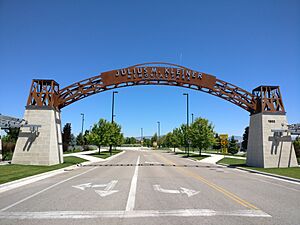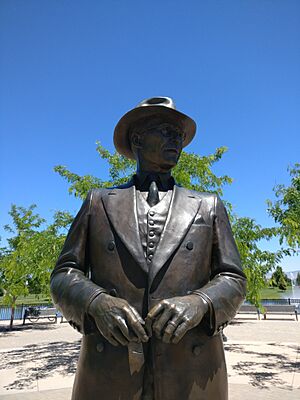Meridian, Idaho facts for kids
Quick facts for kids
Meridian
|
|
|---|---|
|
|
|
| Nickname(s):
The Center of the Treasure Valley
|
|
| Motto(s):
"Built for business . . . designed for living"
|
|
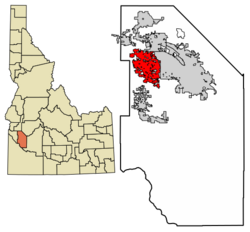
Location of Meridian in Ada County, Idaho
|
|
| Country | United States |
| State | Idaho |
| County | Ada |
| Established | 1891 |
| Founded | 1893 |
| Incorporated as a village | 1903 |
| Incorporated as a city | 1909 |
| Area | |
| • City | 36.39 sq mi (94.25 km2) |
| • Land | 35.08 sq mi (90.86 km2) |
| • Water | 0.07 sq mi (0.20 km2) |
| Elevation | 2,599 ft (792 m) |
| Population
(2020)
|
|
| • City | 117,635 |
| • Estimate
(2022)
|
129,736 |
| • Rank | US: 212th ID: 2nd |
| • Density | 3,567.9/sq mi (1,377.1/km2) |
| • Urban | 433,180 (US: 94th) |
| • Metro | 811,336 (US: 75th) |
| • Combined | 899,574 (US: 67th) |
| Time zone | UTC–7 (Mountain (MST)) |
| • Summer (DST) | UTC–6 (MDT) |
| ZIP Codes |
83642, 83646, 83680
|
| Area code(s) | 208 and 986 |
| FIPS code | 16-52120 |
| GNIS feature ID | 2411083 |
Meridian is a city in Ada County, Idaho, United States. In 2020, about 117,635 people lived there. This makes it the second-largest city in Idaho, right after Boise, the state capital. Meridian is known as one of the fastest-growing cities in Idaho and even in the United States!
Contents
The Story of Meridian
The town of Meridian started in 1891. It was first called Hunter and was located north of where the city is today. Two years later, a group called the I.O.O.F. formed a lodge. They named it Meridian because it was on the Boise Meridian, a special survey line. So, the town was renamed Meridian.
In 1892, the Settlers' Irrigation Ditch was built. This helped turn the dry land into a great place for farming. Meridian officially became a village in 1903. Later, in 1909, it became a city.
How Irrigation Helped Meridian Grow
When early settlers arrived in the Meridian area, they didn't know much about irrigation. They came from places where rain watered their crops. But in Meridian, irrigation was a must! Having a water source was even required to own land from the U.S. Land Office. Today, irrigation districts like Nampa-Meridian and Settlers still bring water to the Meridian area.
Meridian as a Village (1903–1941)
The original town site of Meridian was set up in 1893. It was on land owned by Eliza Ann Zenger. Her husband, Christian, officially registered the town plan and named it Meridian. Many early settlers were relatives who moved west from Missouri. They traveled by wagon, train, or immigrant railroad car. They brought their community groups and churches with them and quickly set up local organizations.
Around the early 1900s, people started growing fruit like apples and Italian prunes. They also built businesses to pack and dry the fruit near the railroad tracks. These fruit businesses continued until the mid-1940s when they were no longer profitable. In 1941, Meridian officially changed from a village to a city.
Trains and Transportation in Meridian
In the early 1900s, people raised $4,000 to build an Interurban rail line. This line connected Meridian to other towns. The tracks were finished in 1908 and went right into the village center. The Interurban Station and Generator building was built in 1912. The train line helped people and goods travel between Meridian, Boise, and Nampa.
The Interurban Company stopped running in 1928 after 20 years. It had been Meridian's main way to connect with nearby communities. Another railroad line, the Union Pacific Railroad spur, opened in 1900. Today, the Boise Valley Railroad uses this line. Many businesses still use it to ship wood, farm products, and chemicals.
The Meridian Creamery (1929–1970)
During the Great Depression, the Ada County Dairymen's cooperative creamery opened in 1929. This was good news for local dairy farmers. It gave them money for their milk, which helped them pay taxes and feed their families. Other people in the community also worked at the creamery, which made a product called Challenge Butter.
The creamery operated seven days a week for 40 years. They kept adding new parts and making improvements while it was still working. Later, Wyeth Laboratories joined with the creamery to make SMA baby formula. After 1970, the creamery stopped its local operations. Farmers then sent their milk to a creamery in Caldwell for processing.
Meridian's Location and Landscape
Meridian is located on a flat plain in the central part of the Treasure Valley. The city covers about 26.84 square miles (69.51 square kilometers) of land and a small amount of water.
Several irrigation canals cross the city, usually flowing from the southeast to the northwest. The Boise River flows north of Meridian, and the Snake River is far to the south. You can see mountains like Squaw Butte and Shafer Butte to the north. The Owyhee Mountains are visible to the far south.
Meridian's Climate
Meridian has a semi-arid climate, which means it's usually dry. It has four different seasons. Summers are hot and dry, with temperatures often going over 100°F (38°C). Winters are cold with some light snowfall.
Rainfall is usually light and doesn't happen very often. It averages less than an inch (25.4 mm) per month. December is the wettest month, and August is the driest. Spring and fall are generally mild and pleasant.
| Climate data for Meridian, Idaho | |||||||||||||
|---|---|---|---|---|---|---|---|---|---|---|---|---|---|
| Month | Jan | Feb | Mar | Apr | May | Jun | Jul | Aug | Sep | Oct | Nov | Dec | Year |
| Record high °F (°C) | 63 (17) |
71 (22) |
81 (27) |
92 (33) |
99 (37) |
109 (43) |
111 (44) |
110 (43) |
102 (39) |
94 (34) |
78 (26) |
65 (18) |
111 (44) |
| Mean daily maximum °F (°C) | 38 (3) |
45 (7) |
55 (13) |
62 (17) |
72 (22) |
81 (27) |
91 (33) |
90 (32) |
79 (26) |
65 (18) |
48 (9) |
37 (3) |
64 (18) |
| Mean daily minimum °F (°C) | 25 (−4) |
28 (−2) |
34 (1) |
39 (4) |
47 (8) |
54 (12) |
60 (16) |
60 (16) |
51 (11) |
41 (5) |
32 (0) |
24 (−4) |
41 (5) |
| Record low °F (°C) | −17 (−27) |
−15 (−26) |
6 (−14) |
19 (−7) |
22 (−6) |
31 (−1) |
35 (2) |
34 (1) |
23 (−5) |
11 (−12) |
−3 (−19) |
−25 (−32) |
−25 (−32) |
| Average precipitation inches (mm) | 1.24 (31) |
1.03 (26) |
1.39 (35) |
1.23 (31) |
1.39 (35) |
0.69 (18) |
0.33 (8.4) |
0.24 (6.1) |
0.58 (15) |
0.75 (19) |
1.35 (34) |
1.55 (39) |
11.77 (297.5) |
People and Population in Meridian
| Historical population | |||
|---|---|---|---|
| Census | Pop. | %± | |
| 1910 | 619 | — | |
| 1920 | 1,000 | 61.6% | |
| 1930 | 1,004 | 0.4% | |
| 1940 | 1,465 | 45.9% | |
| 1950 | 1,810 | 23.5% | |
| 1960 | 2,081 | 15.0% | |
| 1970 | 2,616 | 25.7% | |
| 1980 | 6,658 | 154.5% | |
| 1990 | 9,596 | 44.1% | |
| 2000 | 34,919 | 263.9% | |
| 2010 | 75,092 | 115.0% | |
| 2020 | 117,635 | 56.7% | |
| 2022 (est.) | 129,736 | 72.8% | |
| U.S. Decennial Census 2020 Census |
|||
What the 2020 Census Shows
In 2020, the census counted 117,635 people living in Meridian. There were 48,434 households.
| Race / Ethnicity (NH = Non-Hispanic) | Pop 2000 | Pop 2010 | Pop 2020 | % 2000 | % 2010 | % 2020 |
|---|---|---|---|---|---|---|
| White alone (NH) | 32,270 | 66,123 | 95,526 | 92.41% | 88.06% | 81.21% |
| Black or African American alone (NH) | 155 | 518 | 1,086 | 0.44% | 0.69% | 0.92% |
| Native American or Alaska Native alone (NH) | 143 | 271 | 396 | 0.41% | 0.36% | 0.34% |
| Asian alone (NH) | 432 | 1,312 | 2,938 | 1.24% | 1.75% | 2.50% |
| Pacific Islander alone (NH) | 39 | 102 | 264 | 0.11% | 0.14% | 0.22% |
| Other race alone (NH) | 20 | 87 | 513 | 0.06% | 0.12% | 0.44% |
| Mixed race or Multiracial (NH) | 569 | 1,568 | 5,684 | 1.63% | 2.09% | 4.83% |
| Hispanic or Latino (any race) | 1,291 | 5,111 | 11,228 | 3.70% | 6.81% | 9.54% |
| Total | 34,919 | 75,092 | 117,635 | 100.00% | 100.00% | 100.00% |
What the 2010 Census Showed
In 2010, the census showed 75,092 people living in Meridian. There were 25,302 households, and 19,916 families. The average number of people per household was 2.96. The average family size was 3.33.
About 33.4% of residents were under 18 years old. The median age in the city was 32.5 years.
Meridian's Economy
Several important companies are based in Meridian. These include Blue Cross of Idaho, Jacksons Food Stores, and Scentsy. The Idaho State Police also has its main office and training academy in Meridian. All police officers in Idaho must attend basic training here.
The Village at Meridian is a large shopping and dining area that opened in 2013. It has many stores and restaurants, which helps Meridian's economy.
Arts and Culture in Meridian
Meridian has a vibrant arts scene. The Meridian Symphony Orchestra celebrated its twentieth anniversary season in 2009–10. You can also see art on display at the Initial Point Gallery. This gallery is on the third floor of the Meridian City Hall and is free to visit.
Parks and Fun Things to Do
Meridian's Parks and Recreation department manages 17 public parks. One popular park is Meridian Settlers Regional Park. It hosts free outdoor movies during the summer.
The Meridian Speedway is located south of Old Town Meridian. It's a place where people can watch races.
Meridian is close to Boise and Nampa, Idaho's largest and third-largest cities. This means residents can easily enjoy the fun activities and sports offered in those cities too.
Eagle Island State Park is about 2.5 miles (4.0 km) north of Meridian. It has a man-made lake with a beach, trails for horses and hiking, fishing, and a water slide. The Snake River Birds of Prey National Conservation Area is south of Meridian.
Education in Meridian
The West Ada School District serves most of Meridian. It is the largest school district in Idaho. A small part of Meridian is also in the Kuna Joint School District 3.
How to Get Around Meridian
Most of Meridian is north of I-84. Streets are named with a direction (north, south, east, or west) to show where they are. For example, roads with "north" in their name are north of Franklin Road. Roads with "west" are west of Meridian Road.
Major roads like Black Cat, Ten Mile, Linder, Meridian, Locust Grove, and Eagle run from west to east. Major roads like Chinden (Highway 20/26), McMillan, Ustick, Cherry (or Fairview), Franklin, Overland, Victory, and Amity run from north to south.
I-84 runs between Franklin and Overland roads. Pine is another important road that goes east/west.
A railroad line runs east/west between Pine and Franklin roads. Many of the city's industrial areas are located along this railroad line. The Boise Valley Railroad now owns the line and runs trains on weekdays from Boise to Nampa.
Old-town Meridian is centered around the intersection of Main Street and Pine Street. In this older part of the city, streets are numbered up to 15th Street to the west and 5th Street to the east.
Famous People from Meridian
- William Agee, a business leader
- Mike Gabler, winner of the TV show Survivor 43
- Wilbert Lee Gore, who created Gore-Tex
- Davey Hamilton, an Indy 500 race car driver
- Vern Law, a Major League Baseball player
- Spencer Nead, a former football player for the New England Patriots
- Ron Packard, a former congressman from California who was born in Meridian
- Gracie Pfost, the first woman elected to Congress from Idaho
- Randy Tolsma, a NASCAR driver
- Scott Yenor, a professor at Boise State University
See also
 In Spanish: Meridian (Idaho) para niños
In Spanish: Meridian (Idaho) para niños


